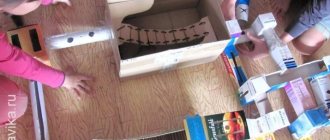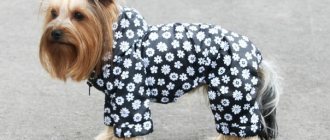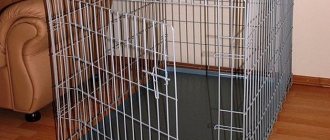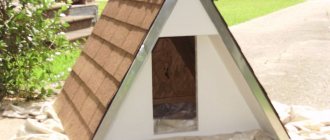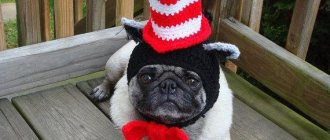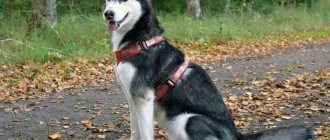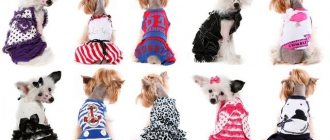Harnesses are used not only for small dogs, but also for large ones. Store-bought products are often poorly made, and therefore, if a large dog jerks or runs suddenly, the weak fastening may break, and this will lead to not very good consequences. You can sew a harness with your own hands even for a shepherd and other large dogs.
What is a harness and why is it needed?
For dogs of large and service breeds, a harness is the trainer’s best assistant; you cannot do without it at dog competitions. If you have a pet of a decorative breed (Yorkie), the harness will make the walk comfortable for all participants in this pleasant process. You can make it yourself using durable materials: leather and braid. Harness for domestic dogs must be equipped with a carabiner and buckle. It is important that the device does not have a lot of weight.
Purpose
Note! The pet should not always be in a walking harness. When the dog moves, it has a different center of gravity than when walking with a collar. Therefore, when you have to walk without equipment, the animal does not like it.
Types and purposes of harnesses
People who live in the city often do not have the opportunity to let their dog run freely. Often the leash for a husky is chosen to be long so that it has more room to maneuver. Only because of it, powerful pressure is created on the vertebrae, no matter how pleasant to the touch and wide the collar may be. The harness transfers this pressure to the chest. Based on the fact that a collar is harmful, we must not forget that an incorrectly selected leash for a husky can also cause harm.
To choose the right leash for your husky, you need to decide on the type of harness. This could be a walking harness if your dog slips out of the collar (or you just don't like the collar). Or a riding harness to which you will attach your bike. Or even a cargo one, similar to the type of harness to which the sled will be attached, for example. It is quite possible that these will be combined options.
For cargo and riding harnesses, you also need a pull (a leash for a husky that is attached to a person or load for shock absorption). The pull is used to prevent the dog from injuring the vertebrae during a sharp jerk. Well, so that the person behind does not fall or the sleigh does not move. An additional element when using cargo harnesses is a “fork” - a spacer that is hooked on both sides of the dog at the end of the harness.
Similar article: The main differences between the Husky and Laika breeds
How to cut
Despite the large assortment of harnesses for large, medium and small breeds of dogs, sometimes you want to make a harness for your pet of the desired shape and size with your own hands. Moreover, this is very easy to do thanks to the availability of a variety of step-by-step instructions and diagrams online that allow you to sew a product to suit every taste. Some manage to do this so well that they take part in master classes.
First you need to take measurements, and then select the fabric. It is better to give preference to fabrics that are used for factory production of harnesses. Mixing them is also allowed. For example, you can combine the use of leather and nylon.
Important! The combination of synthetic and natural fabrics will provide the product with high strength and lighten the weight of the equipment.
Speaking of light weight, paracord collars are characterized by high strength and low weight. For small dogs, such as Yorkies, pugs, dachshunds, and Pomeranians, you can use velor, which is attractive in appearance and inexpensive.
DIY dog harness: step-by-step instructions
There are a large number of options for cutting and sewing a dog harness. The classic option is to sew a pair of leashes together and fix them at 4 points.
Step-by-step instruction:
- Take the braid (it is better to use durable material) and take a measurement using a sewing meter. You need to get the length of the braid that corresponds to the volume of the dog’s body.
- The resulting result is multiplied by two.
- Take a good quality cotton fabric and then cut a strip from it that will match the length of the braid.
- Place the cut strip of fabric between the sides of the braid and machine sew the side seams. It is best to use nylon threads.
- Then sew on a strap that fits on the owner’s hand.
- Make loops along the edges and then secure them with a knot.
- On the side of the ring, leave space for the hem, and on the side of the buckle, for the buckle and hem.
- Secure the rings and buckle onto the loops.
It is necessary to sew, or rather sew together elements of the equipment, with high quality, otherwise the product may tear after the first walk with an active pet that loves to pull.
Important! Fastening hardware must be of high quality.
Rules for self-tailoring
When sewing your own dog gear, it is important to take into account the pet’s temperament and physical strength. The purpose of using the equipment is also important: for regular walks or training.
The material from which the harness will be sewn must be durable, wear-resistant and soft, and should not rub or cause discomfort to the pet. In addition, there should be no difficulty in washing it.
The harness should fit snugly to the animal's body, but should not rub or squeeze, or interfere with the pet's freedom of movement. Checking whether the product is sewn correctly is quite simple: you need to place your palm between the dog’s body and the harness. If it fits easily, then everything is in order: the harness is sewn to the correct measurements, and the dog will be comfortable walking in it. However, the product should not dangle too much, otherwise it will not be difficult for your pet to take it off in a matter of minutes.
Important! It is better to equip the equipment with several fasteners. This is due to the procedure for putting a harness on a pet. The product should be easy to put on and take off.
The straps at the top of the product should not be narrowed, cutting into the animal’s body, as this will be accompanied by pain for the pet. The pattern must match the measurements.
Weights for harnesses
Weights for harnesses are designed for large breeds of dogs. Fighting and service dogs need training that allows them to develop endurance and restore their lack of muscle mass. A weighted harness is ideal for this.
Harness with weights
However, such a product is not made for pets under one year old. This is due to the fact that the bones are just beginning to form, and weights can cause irreparable harm to the dog.
Rings for fastening
In addition to the method of fastening, the product differs in the number of rings with which the leash is secured. For everyday walks with your pet, one ring will be enough.
Working ammunition, as a rule, is distinguished by a large number of rings. There may be three of them. There may also be a special “handle” that allows you to conveniently secure the dog nearby.
Sled dog harnesses include three rings. The harness is fixed on the sides and helps to distribute the load evenly.
Towing type harnesses do not have rings, and therefore the leash is not fixed.
Lining
Riding, cargo and winter types of harnesses must have a lining. It can be played by any material that is soft and duplicates the product from the inside. Many people use old clothes or other fabrics that are low cost. Felt, fleece and plywood are often used. To reduce pressure, foam rubber is sometimes placed between layers of fabric.
If you choose the right type of harness, then accurately take measurements and cut out the product, you can make a dog harness with your own hands. And when there is no time for sewing yourself, ready-made products from zoological stores will help out.
Main types of dog harnesses and their classification
Taking into account the size of the animal, as well as the purpose of using the equipment, types of dog harnesses are classified into the following categories:
- Walking shoes are used in everyday life (when walking with an animal). Durable and wear-resistant material is used to make this accessory. For example, you can use leather or nylon.
Main types
- For small puppies. The dog must not get out of the harness. For them, ammunition is specially selected strictly according to size. It is best to accustom a puppy to an accessory from a very early age, approximately 6 to 9 months. These models are comfortable and lightweight.
- For very tiny puppies. Such products can be found in any store. They are presented in a large assortment. Many of them are equipped with handles on the back. This will make it easy for the owner to pick up the puppy.
- For large dogs. Using a similar model, even a child can walk a large breed dog.
Main and lining material
The main material for sewing can be nylon. It is advisable to make a model combined from leather and nylon. For decorative breeds, it is recommended to take a softer material, for example, velor.
Application of base and lining material
It is convenient to sew harnesses with your own hands, since you can mix materials. Natural fabric in the form of a lining will give the product strength and also provide the animal with an increased sense of comfort. The lining fabric should not only be natural, but also soft, since it comes into contact with the pet’s skin.
Important! The material should absorb moisture well. Felt, fleece, flannel, and jeans are perfect for lining.
Various product options
Trying to ensure maximum convenience and safety, caring breeders have come up with several options for long leashes, dividing them according to their intended purpose. Therefore, the following types are distinguished:
for walks. These harnesses are available for small breeds such as Dachshund, Spitz, etc., and for large breeds;- for sledding and towing;
- leashes with weights (weights), which are used to train and maintain the physical shape of the dog;
- created for auxiliary medical purposes, the task of which is to relieve the stress from the pet’s limbs as much as possible;
- for puppies up to 6 months, preventing paw dislocations and promoting the development of the animal's pectoral muscles.
Also, these products are designed to take into account the individual characteristics of the age and breed of dogs, this is also taken into account in the form of leashes.
Therefore, according to their configuration, they are:
- H-shaped. They are two loops that fit over the head and front paws. A connecting strip is sewn between the loops.
- Reminiscent of 8. They are very similar to the previous ones except that they do not have a bar. This model is considered to be the safest as it prevents the dog from suffocating.
- Vests.
- V-shaped. They resemble the letter V on the dog’s back.
The variety of shapes will allow you to choose a shape for your pet that will not restrict his movements, put pressure on him or cause other inconveniences, while maintaining the maximum level of safety.
Accessories for small pets
Owners who decide to have a small pet often mistakenly believe that various dog accessories are superfluous, nothing like that is unnecessary. I would like to note that when purchasing a puppy, you take full responsibility for its continued existence.
The future fate of the four-legged friend depends on the owners and their proper treatment of the animal. How is it possible to protect a small dog from various troubles? It's simple, you just need special clothing.
Now we can talk about a harness for small dogs and think about its necessity.
When visiting a specialized store that sells products for pets, many owners see on the shelves a large variety of detergents for four-legged animals.
Does your pet need all this? The answer, of course, is yes, it is necessary. Before you bring a puppy into your home, ask yourself some questions:
- A place where your dog will rest and sleep.
- What will your baby eat?
- How will you take it to the veterinary clinic?
- What toys to choose, how the pet will spend its leisure time in the absence of its owners.
- The animal gets cold in cold weather and needs clothing. To do this, you will have to familiarize yourself with the literature that provides an answer to a similar question.
- While walking, your pet needs toys.
- None of the owners want their four-legged friend to receive various injuries while walking.
Rings for fastening
Metal carabiner rings are used for fastening. The fastenings must be strong. It should be borne in mind that the lighter the accessory, the more convenient and comfortable it is for the dog. In addition, the fasteners should not only be strong, but also comfortable. The best option is to make several fasteners.
Braid
If there is no nylon cable, then you should prepare a medium-width nylon braid. To strengthen it, you can use fabric from old jeans. All sections of the braid are melted using a lighter. The braid is thinner than leatherette, so it is reinforced. To do this, the dimensions are multiplied by four, two belts plus double braid.
Advantages and disadvantages
If you have an idea to sew a dog harness yourself, you need to study its pros and cons.
Advantages of a harness over a collar:
- uniform load distribution;
- there are no problems with the musculoskeletal system and pain;
- the neck is not compressed, especially important for small breeds (Chihuahua, Toy Terrier) that have a very fragile skeletal system;
- the dog behaves more calmly.
Minuses:
- it is difficult to control a dog at the moment of a sharp jerk (especially a large breed);
- higher cost compared to a collar;
- after a harness, the dog may refuse to wear a collar;
- Such uniforms are not designed for constant wear; they are used only on the street.
Taking measurements
To ensure that the dog is comfortable and that the harness does not rub on one side and does not dangle on the other, a do-it-yourself harness pattern for a small/large dog is done as follows. The step-by-step master class includes measuring the product using an ordinary tailor's meter.
Important! To make a pattern for a harness for a cat or dog with your own hands, you need to measure the circumference of the chest at the widest point - behind the elbows of the front legs.
The main measurement is the width of the back from the beginning of the withers to the base of the tail. The neck circumference is measured at the place where the collar is usually worn. After this, before writing down the size, you should add 2 cm to the resulting figure so that the equipment is slightly loose and does not restrict movement.
How to take measurements correctly
How to choose and sew a harness
If you have already decided for sure that you need a harness, regardless of whether you buy it or sew it yourself, you need to make a number of necessary measurements.
Top part:
- distance from the blades to the keel;
- breast volume;
- distance from keel to elbow (measured at the bottom).
Middle part:
- distance from the shoulder blades to the last rib;
- from the keel to the last rib;
- from the keel to the maklaks (measured at the bottom).
Rear end:
- distance from the last rib to the hind legs.
If you don’t have the opportunity or desire to buy a harness, sewing one is not that difficult. It is sewn from sling, and soft fabrics are used for lining. It is important to remember that the belts should not be excessively short, otherwise the entire harness will be pulled into the armpit area and rub. It is advisable for the fasteners to be concave in shape to fit the dog’s body, otherwise they will protrude and rub when moving.
A good fit and size of the harness is indicated by the free passage of the hand between it and the dog’s body.
One of the easiest harnesses to sew is the classic X-shaped one. In such a pattern, the beginning comes from the neck, where from the ring the right and left ribbons converge, are sewn into a common wide pillow equal to the length of the chest, and again diverge into two parts. Ribbon lines should be lined. If you are a girl who at work sewed at least an apron, or if you already have a ready-made harness in front of you, sewing will be easier for you. But in general, by setting the patterns to the correct size, and with due persistence, the result is guaranteed.
Similar article: History of the origin of the breed and maintenance of the Siberian Husky
When can you use ammunition with weights?
The period when you can put on a weighted harness depends primarily on the breed of your pet and the nature of your training. Some people are advised to use weights from a year old, others - from a year and a half, and others - not earlier than two years. Therefore, before buying this harness and starting to use it, the owner must consult with an experienced trainer or at least a veterinarian, and then strictly follow all the recommendations received.
Sewing instructions
Do-it-yourself harness for a cat - the pattern is made in the same way as for a dog. To get a cat or dog accessory, you need to follow these steps:
- Initially, you need to take measurements using the method described above. After this, you will have to make a pattern, taking into account the seam allowances. If nylon is used for sewing, then the allowance will be 2 cm. If leather is used, it is necessary to leave approximately 5 mm for the seams.
- The pattern must be placed on the selected lining material and the lining must be carefully cut out. You need to make a stitch along the inside of the future harness.
- Having attached the pattern, the product must be opened around the entire perimeter and a soft braid must be sewn on. On the straps you will also have to make stitches on the outside.
- Next you need to assemble the product. Steel rings should be attached to the back. In order to make an adjustable leash, you will have to attach the rings to the straps.
- The next step is choosing the decor of the product. For small puppies, you can use bright stickers, bows, multi-colored pebbles, and beads.
Correct tailoring of the product If you wish, you can learn how to make a pattern for a bed for a cat or dog.
Manufacturing methods
Every cat owner can easily find harness patterns and sew it at home. To do this, you will need to select one of the available options and strictly follow the instructions provided.
From old jeans
You can use old clothes or worn jeans to make a useful accessory. In this case, you will need fabric from the legs and a belt.
Items required for work:
- unused jeans;
- sheet of cardboard;
- scissors;
- needle and thread;
- button;
- rivets;
- tailor's centimeter.
Before starting work, you need to take measurements of your pet. In order to make a harness, you will need the girth of the animal's neck and chest.
Following actions:
- Individual details of the future product are drawn on a sheet of cardboard. In this case, it is important to accurately maintain the dimensions that correspond to the measurements taken.
- Using scissors, cut out the blanks and transfer them to denim.
- Fabric parts are produced in the same way.
- They are sewn by hand using short stitches. The thread should be dense and strong so that the seams do not come apart while walking with your pet.
- The loops intended for the torso and neck are connected to each other using a fabric jumper. It is sewn to both parts of the product with dark threads.
- A leash is cut out of the same material. Its length should be at least one and a half meters and width - 3 cm.
- A button is placed at one end of the workpiece.
- A rivet is installed approximately in the middle of the leash.
- The product part is threaded through a fabric jumper and secured with a button.
- For greater reliability, add another rivet.
We invite you to read: Toxoplasmosis in cats: causes, symptoms, treatment and prevention
Assembling a harness from leather is as easy as from fabric. It is important to consider that such material can only be used to create a summer version. A more closed winter leather accessory will be too heavy, so the cat will experience discomfort.
Materials and tools:
- 3 thin leather belts;
- rings;
- buckles;
- carbine;
- scissors;
- awl;
- thick needle;
- strong threads.
Step-by-step instruction:
- First of all, pick up your pet and take measurements. To work, you need to know the girth of the chest (at the widest point) and neck.
- In accordance with the obtained dimensions, 2 parts are cut from the strap. At the same time, do not forget to leave allowances of 2 cm.
- From another leather belt, a piece is obtained that is necessary to fasten the two main structural elements.
- The third strap is used to form a leash. For a small pet, a length of 1.6 m will be sufficient.
- At the next stage of work, they begin to connect all the parts into a single structure. To do this, take thick threads and a thick needle and alternately sew the jumper to one and the second loop.
- A carbine is attached to the future leash.
- A loop is formed and sewn on the opposite side, the size of which should be no smaller than a person’s fist.
- A hole is made in the strap with an awl, and then the leash is attached to the harness.
If a person is making a harness for his pet for the first time, then it is better to choose this option. It is interesting because you don’t need to have any knowledge or skills to do the job. In addition, the finished product almost never causes irritation to the animal’s skin or problems with the fur.
To work you will need:
- a piece of fleece fabric;
- a piece of raincoat fabric;
- checkered notebook sheet;
- braid;
- strap;
- rubber;
- lock;
- fastening elements;
- decorative ribbon;
- tailor's centimeter;
- scissors;
- needle with thread.
Correct sequence of actions:
- Take the finished accessory and transfer all its dimensions onto a notebook sheet. To simplify this work, you can take graph paper.
- The workpiece is cut out with scissors, applied to the raincoat fabric and secured with pins or binders (paper clips).
- After this, carefully transfer all the details onto the fabric.
- The paper blanks are removed, and parts are cut out along the drawn lines.
- All the same actions are performed with a piece of fleece fabric.
- The location of the braid is marked on the material and then stitched.
- The finished element will be located along the cat's spine, so an additional layer of fabric is sewn here. Thanks to this, it will be possible to avoid strong friction of the material against the animal’s fur.
- A small loop is left at the edge of the braid, into which a special ring is threaded. It is necessary in order to securely attach the finished product to the leash.
- The neck is made from a piece of raincoat fabric.
- An elastic band is sewn along its perimeter, which will allow you to change the diameter of this element.
- For decoration, braid is used, which is sewn to the lower and upper parts of the neck.
- The finished part is attached to the base, bending the edges inward.
- Carry out a test fitting and check the accuracy of all sizes.
- After this, they begin to make the leash. For it, take a leather strap and cut off a part of the required size (no more than 1.5 m).
- The edge is stitched and decorated with braid.
- The leash is attached to the installed ring and the reliability of the connection is checked.
- Decorative tape is sewn to the edges of the finished product.
- The harness is decorated with various objects (rhinestones, stones, bows, etc.).
A harness is a must-have item that every cat owner should have. Finished products can be bought at any pet store, but there is no guarantee that they will suit your pet. The best option would be to make a leash for your cat with your own hands. If you avoid mistakes and choose the dimensions accurately, your pet will like this piece of equipment.
Choosing a wardrobe and harness
Do not dress your pet until the baby reaches six months of age. The reason is fragile bones, which also grow quickly. The joints on the front paws can turn outward, deforming the paws and turning them inside out. An analogy arises with walkers for small children; they cannot be used until a certain age.
Without heeding the owners' advice, animals run the risk of becoming regular visitors to the veterinarian. The best option is to buy clothes when your pet reaches six months of age.
When choosing a suit for walking, pay attention to the quality and other characteristics of the product: varied comfort, softness, durability.
In a pet store you can choose a harness: used when prescribed by a veterinarian, for large-bred pets they are suitable with larger belts, choose a product for puppies that have reached six months, insulated ones for pets with short hair.
It is extremely important to choose the right size for the harness, so that the dog’s paws rub and its movements are not hampered - the harness is selected from a soft material, one of the main selection criteria is that the fabric should wash well.
It is better to give preference to several fasteners on the harness to avoid the difficulty of putting it on your baby.
You cannot wear a harness all the time; you must remove the product at home; you can sometimes alternate with a leash and collar.
Features of sewing a riding harness
Harnesses for riding and kits for skijoring, bikejoring, cani-cross (towing belts, pulling, harnesses) are an excellent option for joint active recreation and sports with your dog. Suitable for different seasons and people with different levels of physical fitness (in winter, a dog can pull a skier, in summer - a cyclist or a person running behind it).
Note! Unlike power work, for which weight harnesses are used, riding gear is designed to handle light weights over long distances.
Types of harnesses for sled dogs
The sled type of harness is suitable for massive dogs such as Malamute, Husky and Samoyed. The riding harness for dogs has a high level of durability and provides comfort for the animal. These products are difficult to find in a regular pet store, so the equipment is made to order. The device has several belts and rings with which they are attached.
The tow belt is designed for use in canicross, skijoring and bikejorring competitions. Using this type of harness is very convenient, because the skier’s hands remain free.
There is a shock absorber between the tow belt and the traction leash, which softens sharp jerks and increases the efficiency and comfort of the dog and skier. There are also several modifications of the tow belt: sports, touring and children's.
Recognized
FCI recognized breeds include:
- husky;
- Samoyeds;
- Alaskan Malamutes;
- Greenland sled;
- Chukotka sledding
Siberian Husky
Siberian Husky
The Siberian is medium in size, has a thick undercoat and dense coat. Its powerful frame allows it to easily transport small loads.
The Siberian Husky is not suitable for city life, as its restless nature and independence become the reasons for the destruction of the apartment.
Rules for putting a harness on a pet
Putting an accessory on a pet is a difficult procedure at first. It is recommended to choose models with multiple fasteners. Before putting a harness on your pet, you should calm your dog. That is, this action should not cause unpleasant emotions, and in addition, the animal does not need to raise its paws.
How to properly put the product on your pet
Need for a harness
Initially, the harness was used as a harness for sled dogs. Over time, pet owners have considered the benefits of this accessory. The main advantages of its use are the comfort of use for both the dog and its owner. If the collar may come off when tugging, the harness will securely hold the naughty pet without causing harm to him.
Despite the positive properties, you cannot use only a harness. It is recommended to alternate it with a collar. In this way, the best results for the dog’s health are achieved.
Accessories are different and are used not only for control, but also for training, treatment and keeping animals warm. Depending on the purpose, the design of the harness may change, but despite this it remains simple and can easily be made at home.
Depending on the size of the pet and the purpose of the accessory, materials and fasteners are chosen, giving preference to dense synthetic fabrics with a high margin of strength and protection from moisture. Sewing a harness is not at all difficult; just look at the patterns that are freely available on the Internet.
The process of creating a harness
The process of creating a traditional rat harness involves a few simple steps:
- First of all, the pet is measured according to the above parameters.
- Make two sections taking into account the length of the locks or additional length in case of using Velcro. The resulting closed parts must match measurements “a” and “b” in the pattern presented above.
- The finished elements are connected with strips, the length of which is equal to measurement “c”.
- A steel ring or loop required to secure the leash is attached to the element located under the pet’s limbs.
- The locks are sewn into the rodent's belly or back.
Important! Do not put a collar on a rat. If it is not tightened tightly, the pet can easily slip out, and if it is tightened too tightly, there is a high probability that the rodent may suffocate.
How to choose in a store
When buying ammunition for your pet, it is better to take it with you, since choosing a product in absentia is a complex process. Many stores allow you to try on accessories. A good harness should not dangle on the animal. If the accessory is not selected in size, then when moving it will move to the sides or slide down. The best alternative is to purchase a product with adjustable straps. It is not recommended to take tight models, so as not to make it difficult for the animal to breathe.
How to make the right choice
In conclusion, it should be said that all parts must be sewn firmly and efficiently so that the harness does not fail at the dog’s first serious tug. Before putting it on your dog, you need to determine the strength of the product. Belts can be made on rings to adjust their length.
*Prices are valid for January 2021*
How to properly walk your dog on a leash
In order not to run after the dog while walking and for both parties to enjoy the walk, you should definitely draw up a plan and exercise plan and strictly adhere to them:
- The first part of the walk should consist of natural and calm walking with the pet in the “side by side” position along the sidewalk or path in the park. At the same time, the pet learns to recognize the person as the leader in their small pack and follow him unquestioningly.
- The second stage of walking is the movement of the dog without a leash. To do this, you need to choose an area as free as possible from people and other animals, where the pet can actively run around, mark the territory and fulfill its natural needs. The owner must always be on guard, the dog must obey and return to the person unquestioningly.
- The third part of the walk is communication with other dogs. To do this, it is advisable to find a dog park and visit it every day. This is very necessary for the pet to maintain its sociality and friendliness.
- In conclusion, it is advisable to do a little training, repeat the learned commands, and continue learning new ones.
It is advisable, in order to carry out a full walk and fulfill all its goals, to have two leashes with you, for example, a tape measure and a leader or re-strap.

